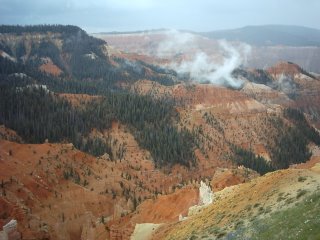National Park Service Turns 90!
 McDowell Mountain in winter
McDowell Mountain in winter Red Canyon, near Bryce
Red Canyon, near Bryce Arizona
Arizona Cedar Breaks national Monument, Utah
Cedar Breaks national Monument, UtahWith the stroke of his pen, then President Woodrow Wilson signed the National park Service Act 90 years ago this month. "To conserve the scenery and the ntural and historic objects and the wild life therein and to provide for the enjoyment of the same...unimpaired for the enjoyment of future generations."
Thirty-six national parks were brought under one umbrella with the signing of this law. James Bryce (British Ambassador to the U.S.) called it the "best idea America ever had." In 1916, James McFarland, a visionary in the national park process, said "It is the one thing we have that has not been imported." Many other countries had preserved gardens and such for the welthy classes, but nothing had been done to date on this scale, for every member of a country.
having grown to over 375 sites, blanketing over 80 million acres, the NPS covers it all. From parks, monuments, seashores, beaches and rivers, historical sites, and battlefields, even things like British canon surrendered at Yorktown are looked after. The NPS has the derringer pistol that killed Abe Lincoln, and even a breed of short legged cow that was bred by President Lyndon B. Johnson.
With vast areas o cover, and ever dwindling resources to cover it, the NPS is very much aware of the fact that it's holdings are some of the last natural reources in North America. The 12,000 employees have to cover things like Bison herd management in Yellowstone, mysterious Saguaro Cactus deaths in the Southwest, how to protect dwindling sea turtle populations in the Virgin Islands, and how to improve water quality in the Florida Everglades.
In 1978, Jimmy Carter aquired another 40 plus-million acres of Alaskan wilderness. The park service employees there have to fly (mostly) in and out of the areas there, as a result of the remoteness of the landscape. From 1970 to 1990, the number of visitors to the NPS parks has tripled. The numbers are staggering, going from 80 million visitors to 257 million in just three decades! Unfortunately, budgets are being far outpaced by the number of visitors, forcing hard choices on those responsible for maintenance, staffing, and equipment repairs.
The good news is, that many visitors means tht people are getting outside of their homes and seeing nature for what it is. Children see what it was like to cross the country in a wagon train in the hot and rugged Southwest. Docents like Festus Bourne can show you how to carve a duck from a block of wood in the Blue Ridge Mountains of Virginia, and Clark Moore will teach you how to throw a punch at Martin Luther King Jr. national Historic Site in Atlanta Georgia. Get out there, and send me a pic when it's over!
Capn Chris

0 Comments:
Post a Comment
<< Home